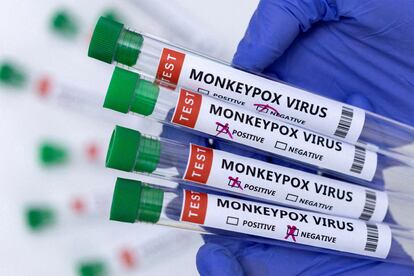WHO debates declaring monkeypox virus a global emergency
With cases now exceeding 3,500 in 42 countries, the organization could raise the health alert to the same level as Covid-19 and the effort to eradicate polio

The emergency committee of the World Health Organization (WHO) is holding a meeting this Thursday in Geneva to assess whether the monkeypox outbreak, which has affected more than 3,500 people in at least 42 countries in six weeks, constitutes a “public health emergency of international concern.” This is the highest level of alert that the agency can declare, a status that the coronavirus pandemic and the effort to eradicate polio currently have.
Declaring a global emergency would seek to increase coordination between countries and reinforce mechanisms to actively search for cases and implement measures to help curb the global circulation of the virus. According to WHO sources, the results of the meeting will be communicated at a news conference on Friday afternoon or Saturday morning, and a statement will also be released.
The meeting of the committee is taking place in an environment of growing concern about the rise in cases registered in non-endemic areas outside of Africa, especially in Europe but also in the Americas, with several cases also reported in Asia and Oceania. An international health alert was launched by the United Kingdom in mid-May, and since then cases have been growing in this country (793), as well as in Spain (more than 800), Germany (592), Portugal (317), France (277) , Canada (245), the Netherlands (167) and the United States (156), according to figures available on Thursday morning. The data, however, is constantly changing as countries update their records, something that not all do at the same pace.
Antonio Alcamí, a researcher specializing in the viruses that cause the different types of smallpox and who works at Spain’s National Research Council (CSIC), feels that it would be warranted to declare the monkeypox outbreak a global emergency. “The main reason is that the virus has spread to many countries and this is the way to ensure that everyone contributes the means to properly measure the scope of the outbreak. In the current situation, it is very likely that many countries have more cases than those that are being detected,” he said.
One of the questions that is on the table is whether national health systems are looking in the right places as they search for cases. Part of the growth is due to tracing difficulties encountered by several countries, according to several studies. The vast majority of positives are related to festivals, parties and other events in which men who have relationships with other men meet and close contact occurs, which has been revealed as the main route of infection. Many of the patients state that they cannot identify, or prefer not to, their risk contacts.
But in recent days several scientists have spoken out in favor of a broader case definition, urging authorities to expand the criteria that a patient must meet in order to get tested. A letter published in the medical journal The Lancet on June 15 by a dozen scientists warned that “current case definitions of monkeypox would miss the case of a heterosexual patient with a characteristic vesicular-pustular rash but no travel history or contact with confirmed infection. The latter description best fits those people who most typically become infected in endemic areas.”
“Many cases may be escaping us because the symptoms observed are generally milder than expected and can be confused with many other diseases,” notes Antonio Alcamí. The letter published in The Lancet maintains that “to untrained eyes, monkeypox could easily be mistaken for other dermatological diagnoses within sexual health clinics or primary care (eg, chickenpox, varicella zoster, herpes simplex, syphilitic chancre, gonorrhea, or molluscum contagiosum).”
Antonio Alcamí acknowledges that there are still several questions to be answered to explain the current extent of the outbreak, such as whether there are patients who can be almost asymptomatic or whether the virus is also spread by the respiratory route.
“The epidemiological data we have so far shows that the vast majority of infections have been by direct contact. It is possible that they can also be transmitted by air, although it does not seem to be a very effective way. Studies must now determine what percentage of infections may be occurring in this way.”
Tu suscripción se está usando en otro dispositivo
¿Quieres añadir otro usuario a tu suscripción?
Si continúas leyendo en este dispositivo, no se podrá leer en el otro.
FlechaTu suscripción se está usando en otro dispositivo y solo puedes acceder a EL PAÍS desde un dispositivo a la vez.
Si quieres compartir tu cuenta, cambia tu suscripción a la modalidad Premium, así podrás añadir otro usuario. Cada uno accederá con su propia cuenta de email, lo que os permitirá personalizar vuestra experiencia en EL PAÍS.
¿Tienes una suscripción de empresa? Accede aquí para contratar más cuentas.
En el caso de no saber quién está usando tu cuenta, te recomendamos cambiar tu contraseña aquí.
Si decides continuar compartiendo tu cuenta, este mensaje se mostrará en tu dispositivo y en el de la otra persona que está usando tu cuenta de forma indefinida, afectando a tu experiencia de lectura. Puedes consultar aquí los términos y condiciones de la suscripción digital.









































